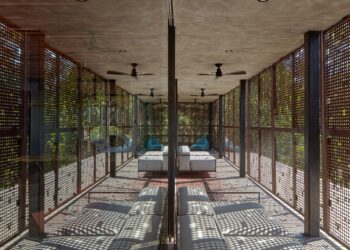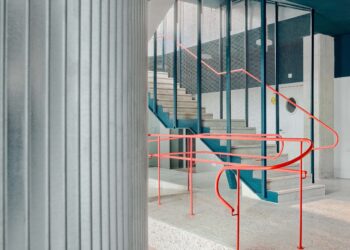A promenade helps connect a small town with its river-valley environs
계곡을 따라 펼쳐져 마을 산책로

Located on the edge of a small town by the river valley, the promenade is a landscape intervention on the side of a road – a ceramic carpet that unrolls to follow the line of the existing stone wall that holds the terrain. It creases and folds as the trees and roads cross its path, amongst them, slabs of concrete act as seating areas looking out over the backwaters. The surfaces of these slabs are polished, as if sanded and eroded by weathering and use. Other elements, such as bollards, guide the direction of flow.
스페인 동부 발렌시아 산악지대에 계곡을 따라 형성된 작은 마을 ‘레 코베스 데 빈로마’. 지역의 유명한 도자기 산업을 부흥시키고자 진행된 건축 공모전에서 발렌시아 출신의 건축가 ‘보나 피데 탈러’의 ‘레 코베스 데 빈로마 산책로’ 프로젝트가 최종 우승작으로 선정됐다. 가파르고 높은 지형과 좁은 도로 탓에 접근이 쉽지 않았던 계곡에 산책로를 두어 만남과 휴식의 장소로 재탄생시켰다.







The path wends into a small plaza. This space is of urban, domestic attributes, an outdoor room for meeting and rest. A fountain is located at the center, expelling its water through an open drain to the natural terrain below. From this ledge of rusted mesh and stone the river can be seen, its white marbled riverbed, as well as the abandoned barns on the other side of the valley. The dry-stone wall that holds the court follows a footpath that goes down to an old wheel, coming from the high levels of the town above. The stepped slope is paved with riverine stones set in between salvaged bush-hammered masonry – of the type found in the nearby hilly streets – all under the shade of the pines.
Materiality is key, particularly in such a delicate environment. The pavement is built using blocks of recycled low value ceramic stock, cut and reassembled, resulting in a warm red pinstripe effect. Along with stone work, stone paving of different sorts and rusted steel, the intervention blends into the palette of the landscape.
자연경관이 아름다운 마을에서 잘 이용되지 않던 협소한 도로를 사람도 함께 이용할 수 있도록 길을 넓혀 산책로를 만들었다. 경사지를 따라 길게 뻗은 산책로 중간중간에 세 개의 작은 광장을 두고, 광장을 이어주는 길목 곳곳에는 콘크리트 벤치를 두어 시시각각 변하는 자연풍경을 바라보며 휴식을 즐기게 했다. 계곡에서 광장 끝까지 오르기전 중앙 광장에 설치된 식수대는 산책로를 더 오르기 전 맛보는 달콤한 단비같은 존재이다.
지형을 따라 마을 아래까지 이어진 산책로는 주변 자연재료를 풍부하게 사용했다. 계곡과 산책로를 잇는 계단은 주변 바위와 돌을 이용해 포장했고, 난간은 코르텐 강으로 마감하여 최대한 자연에 가까운 색감으로 이질감을 덜어냈다. 바닥 마감은 지역 특산물인 도자기를 재활용하였다. 재가공된 적갈색의 도자기 타일에 긴 줄무늬의 결을 넣어 독창적인 패턴을 가진 산책로를 만들었다. 붉은 타일의 산책로는 스페인 작은 마을에 따스함을 불어 넣어 주고 산과 계곡이 흐르는 마을 주변 풍경에 자연스럽게 동화된다.





From start to finish the project was drawn entirely by hand, with no software involved whatsoever. This resulted in a beautiful set of drawings that narrate the whole process. During the development, the drafting table at the studio was held hostage by a 1/50 floor plan of roughly 5 meters of tracing paper. Drawings piled up, one superseding the other, in an untidy chronological process. The result gathers trials and errors, thoughts, ideas, details and work instructions, the temporal dimension of the process condensed in these documents. On the tablecloths of paper each element acquired its own nature, demanding its own need for definition, in terms of space or even through three-dimensional representation outside the unfolding rules of the two-dimensional drawings. A dance of pieces, partial views and details are choreographed by, and referenced to, the outline of the plan.
The project developed by Bona fide taller on the edges of the small town of Les Coves de Vinromà, in Castellón, Spain, is the result of a competition promoted by the ceramic industry of the region.





Project: Promenade in Les Coves de Vinromà / Location: Les Coves de Vinromà, Castellón, Valencia, Spain / Architect: Bona Fide Taller / Lead designer: Alejandro Martínez del Río / Area: 5,382ft2 / Completion: 2020 / Photograph: Oleh Kardash Horlay



































